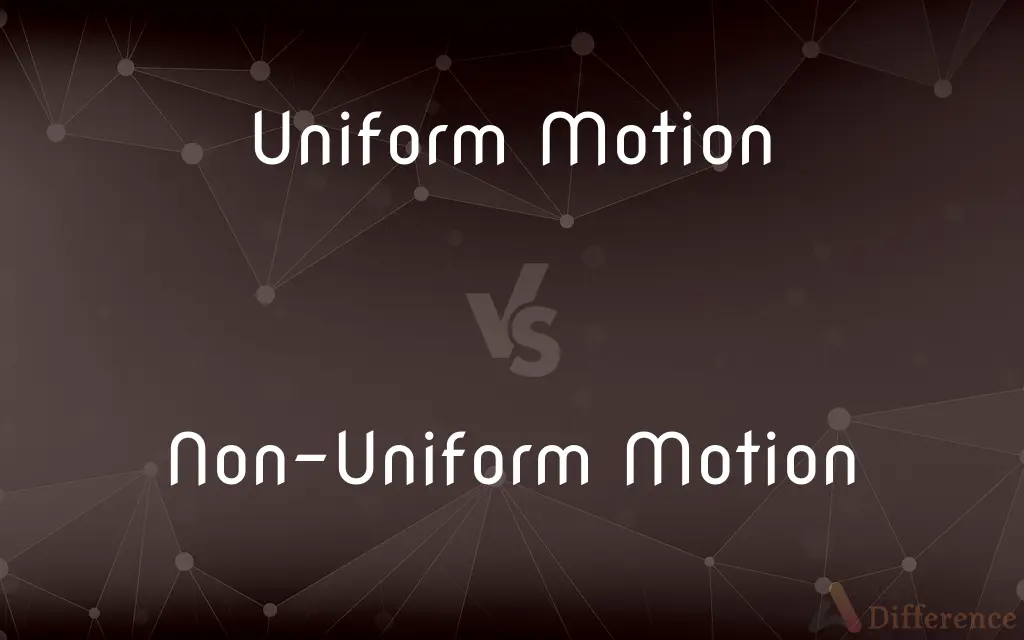Uniform Motion vs. Non-Uniform Motion — What's the Difference?
Edited by Tayyaba Rehman — By Fiza Rafique — Published on December 31, 2023
Uniform Motion is when an object covers equal distances in equal intervals of time. Non-Uniform Motion is when an object covers unequal distances in equal intervals of time.

Difference Between Uniform Motion and Non-Uniform Motion
Table of Contents
ADVERTISEMENT
Key Differences
Uniform Motion signifies an object's motion that remains consistent over time. This implies that the object travels equal distances in equal intervals, maintaining a steady velocity. Non-Uniform Motion, in contrast, means the object's movement is inconsistent, covering unequal distances in equal time spans.
In the context of Uniform Motion, it's simpler to predict an object's position at any given point in time because of its consistency. Non-Uniform Motion complicates this predictability, as the object’s velocity is not constant, making its future position less predictable.
When we discuss Uniform Motion, we often think of objects that move on a straight path without any external forces altering their velocities, such as a car on a straight road at a constant speed. On the other hand, when we talk about Non-Uniform Motion, the picture that comes to mind could be a car accelerating or decelerating due to various factors.
In scientific studies, Uniform Motion can be represented by a straight line on a distance-time graph, which is linear. Non-Uniform Motion is represented by a curved line, indicating variable distances covered over the same intervals of time.
Lastly, while Uniform Motion can be considered a special case of motion due to its constant velocity, Non-Uniform Motion is more common in the natural world. From speeding cars to the changing velocities of falling objects, Non-Uniform Motion embodies most of the movements we observe daily.
ADVERTISEMENT
Comparison Chart
Definition
Covers equal distances in equal time intervals.
Covers unequal distances in equal time intervals.
Predictability
Easier to predict the future position.
Harder to predict the future position.
External Influence
Rarely influenced by external forces.
Often influenced by external forces like acceleration.
Graph Representation
Represented by a straight line on a distance-time graph.
Represented by a curved line on a distance-time graph.
Frequency in Nature
Less common in natural scenarios.
More common in natural scenarios.
Compare with Definitions
Uniform Motion
Uniform Motion represents a steady velocity of an object.
The airplane maintained Uniform Motion at a steady altitude and speed.
Non-Uniform Motion
Non-Uniform Motion often results from external influences.
Due to the steep slope, the ball's Non-Uniform Motion was evident.
Uniform Motion
Uniform Motion is the consistent movement of an object over time.
The car drove at 60 mph, showcasing Uniform Motion.
Non-Uniform Motion
Non-Uniform Motion implies an object's varying speed or direction over time.
The roller coaster exhibited Non-Uniform Motion with its rapid twists and turns.
Uniform Motion
Uniform Motion means traveling equal distances in equal time frames.
The train, demonstrating Uniform Motion, covered 50 miles every hour.
Non-Uniform Motion
Non-Uniform Motion means covering different distances in equal time spans.
The bird displayed Non-Uniform Motion, sometimes darting fast and sometimes gliding slowly.
Uniform Motion
Uniform Motion is a motion with no change in speed or direction.
The conveyor belt's Uniform Motion made the packages move at a constant pace.
Non-Uniform Motion
Non-Uniform Motion can be acceleration or deceleration.
The skater’s Non-Uniform Motion was clear when he sped up and slowed down repeatedly.
Uniform Motion
Uniform Motion is unaffected by external accelerating or decelerating forces.
Despite the strong winds, the drone showed Uniform Motion.
Non-Uniform Motion
Non-Uniform Motion signifies a change in an object's velocity.
The car, displaying Non-Uniform Motion, accelerated down the highway.
Common Curiosities
What is Uniform Motion?
Uniform Motion is when an object covers equal distances in equal intervals of time.
Is acceleration involved in Non-Uniform Motion?
Yes, Non-Uniform Motion can involve acceleration or deceleration.
How is Uniform Motion represented on a graph?
Uniform Motion is represented by a straight line on a distance-time graph.
Is a car moving at a constant speed an example of Uniform Motion?
Yes, a car moving at a constant speed showcases Uniform Motion.
How about Non-Uniform Motion on a graph?
Non-Uniform Motion is represented by a curved line on a distance-time graph.
Can a car accelerating be an example of Non-Uniform Motion?
Absolutely, a car that is accelerating demonstrates Non-Uniform Motion.
Can Uniform Motion change direction?
No, Uniform Motion maintains a consistent speed and direction.
Which is more common in nature, Uniform or Non-Uniform Motion?
Non-Uniform Motion is more common in natural scenarios.
How is Non-Uniform Motion different?
Non-Uniform Motion is when an object covers unequal distances in equal intervals of time.
Is Non-Uniform Motion affected by external factors?
Yes, Non-Uniform Motion is often influenced by external forces like acceleration.
Why is Uniform Motion considered predictable?
Because it covers equal distances in equal time, making future positions easier to determine.
Share Your Discovery

Previous Comparison
Peas vs. Beans
Next Comparison
Pre-Shipment Finance vs. Post-Shipment FinanceAuthor Spotlight
Written by
Fiza RafiqueFiza Rafique is a skilled content writer at AskDifference.com, where she meticulously refines and enhances written pieces. Drawing from her vast editorial expertise, Fiza ensures clarity, accuracy, and precision in every article. Passionate about language, she continually seeks to elevate the quality of content for readers worldwide.
Edited by
Tayyaba RehmanTayyaba Rehman is a distinguished writer, currently serving as a primary contributor to askdifference.com. As a researcher in semantics and etymology, Tayyaba's passion for the complexity of languages and their distinctions has found a perfect home on the platform. Tayyaba delves into the intricacies of language, distinguishing between commonly confused words and phrases, thereby providing clarity for readers worldwide.













































